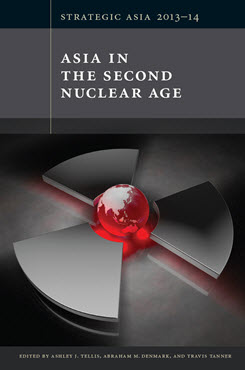China's Nuclear Modernization
Surprise, Restraint, and Uncertainty
This chapter considers the evolution of China’s nuclear posture and the current status of its nuclear modernization programs and draws implications for the Asia-Pacific region and the U.S.
EXECUTIVE SUMMARY
This chapter considers the evolution of China’s nuclear posture and the current status of its nuclear modernization programs and draws implications for the Asia-Pacific region and the U.S.
MAIN ARGUMENT
China is continuing to modernize its strategic forces, including by adding new capabilities such as conventionally armed missiles. The modernization of its nuclear force is driven by a complex set of motivations, including the perceived need for continual technological advancement, responses to perceived strategic challenges, and ideological considerations. China’s nuclear capability is oriented toward maintaining a credible strategic retaliatory capability, primarily through the development of increasingly advanced medium-range and intercontinental ballistic missiles. This process, combined with broader changes in all aspects of life in China, raises questions about whether such modernization will occur within the historical framework of the country’s policy on nuclear weapons or mark a fundamental transition.
POLICY IMPLICATIONS
- The dynamics of strategic stability between the U.S. and China will be fundamentally different from what existed between the U.S. and the Soviet Union, primarily because of significant disparities in power and capability as well as profound differences in how Washington and Beijing see one another and the role of nuclear weapons in their bilateral relationship.
- The major policy choice for the U.S. involves whether to accept a Chinese “assured destruction capability” as a strategic fact and, if so, whether to publicly acknowledge this fact.
- A negotiated joint statement on strategic stability, in which the two countries agree to work toward stabilizing the current strategic balance, may provide a basis for ongoing discussions.
If the history of the United States’ understanding of China’s nuclear capabilities and force development could be summarized in one word, it would be “surprise.” When the People’s Republic of China (PRC) tested its first nuclear device in 1964, U.S. policymakers and analysts were not only surprised that China possessed enough fissile material to conduct a test but were further surprised to learn that it had used highly enriched uranium rather than plutonium for its first device. China’s turbulent internal politics, as well as its different historical and ideological circumstances, have conspired to produce an approach to nuclear weapons and deterrence that is a puzzle to most U.S. observers. The Chinese arsenal appears relatively small and vulnerable, almost provocatively so to a Western observer. China possesses a few hundred warheads available for deployment on ballistic missiles, but the warheads are stored separately from the missiles and are constrained by a policy of “no first use” (NFU) that requires the country’s nuclear forces to ride out a first strike.
Given this history, assessments of China’s current and future nuclear posture and strategy should be grounded in a humble acknowledgement of the limitations of external analysis. Although information about Chinese strategic forces is far better today than it was in 1964, significant limitations remain. The PRC’s current capabilities and the intentions of its leadership, as well as its future plans for the strategic force, remain obscured by a combination of intentional opacity, historical and ideological dogma of uncertain practical significance, and a seemingly genuine uncertainty in Beijing about several key issues.
With such caveats in mind, China is continuing to modernize its strategic forces, including through the introduction of new capabilities such as conventionally armed strategic missiles, indications of interest in missiles capable of carrying multiple warheads, and the construction of the foundation of a viable submarine-based deterrent. This process raises fundamental questions about the future of China’s nuclear modernization—whether it will occur within the country’s traditionally restrained approach to nuclear weapons, or whether new capabilities will enable Chinese leaders to choose a fundamentally different path.
The first section of this chapter surveys the evolution of China’s nuclear program and is followed by an examination of the key features of China’s current nuclear strategy, capabilities, and posture. The next section discusses the reasons for Chinese strategic restraint and considers questions about the country’s NFU policy. The chapter then concludes by assessing the regional and global impact of China’s nuclear modernization and by drawing implications for the United States.
The History of China’s Nuclear Weapons and Missile Development
China’s acquisition of nuclear weapons and ballistic missiles was initially driven by a desire to possess the same “sophisticated weapons” as other major powers. From the very beginning in the late 1950s, the Chinese leadership was committed to developing large, multi-megaton thermonuclear warheads that could be delivered at intercontinental ranges by ballistic missiles. This was an audacious goal for the poor, technologically inept PRC of the Great Leap Forward era. Yet China moved quickly in its nuclear testing program to develop thermonuclear warheads—burning thermonuclear fuel in its third nuclear test (prior to demonstrating a deliverable fission device) and successfully conducting a staged thermonuclear explosion in its sixth test. At the same time, China pursued an ambitious missile development program called “eight years, four missiles” (banian sidan). [1] Although the four missiles are usually described as aspirations in terms of range, with…
Endnotes
[1] John Wilson Lewis and Xue Litai, China Builds the Bomb (Stanford: Stanford University Press, 1988), 211–12.
Strategic Asia
The Strategic Asia annual edited volume incorporates assessments of economic, political, and military trends and focuses on the strategies that drive policy in the region. Learn more about Strategic Asia.


